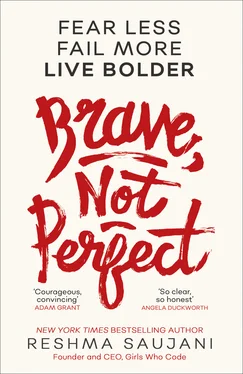I know this story because today, Erica is forty-two and a good friend of mine. She is still supersweet with a dazzling smile—and still a prisoner of her own perfectionism. A successful political consultant with no kids, she works until after midnight most nights to impress her colleagues and overdeliver for her clients. Every time I see her she looks fabulously put together; she’s that friend who always says just the right thing, always sends just the right gift or note, and is always on time. But just like her sixteen-year-old self, she’ll only reveal privately that she still feels strangled by the constant need to please everyone. I asked her recently what she would do if she didn’t care what anyone else thought. She immediately ticked off a list of goals and dreams she wished she had the guts to go after but wouldn’t dare, ranging from telling her biggest client that she disagrees with his strategies to moving out of the city and having a child on her own.
Our culture has shaped generations of perfect girls like Erica who grow up to be women afraid to take a chance. Afraid of speaking their minds, of making bold choices, of owning and celebrating their achievements, and of living the life they want to live, without constantly seeking outside approval. In other words: afraid of being brave.
From the time they are babies, girls absorb hundreds of micromessages each day telling them that they should be nice, polite, and polished. Adoring parents and caretakers dress them impeccably in color-coordinated outfits (with matching bows) and tell them how pretty they look. They are praised mightily for being A students and for being helpful, polite, and accommodating and are chided (however lovingly) for being messy, assertive, or loud.
Well-meaning parents and educators guide girls toward activities and endeavors they are good at so they can shine, and steer them away from ones they might find frustrating, or worse, at which they could fail. It’s understandable because we see girls as vulnerable and fragile, we instinctively want to protect them from harm and judgment.
Our boys, on the other hand, are given freedom to roam, explore, get dirty, fall down, and yes, fail—all in the name of teaching them to “man up” as early as possible. Even now, for all our social progress, people get a little uncomfortable if a boy is too hesitant, cautious, or vulnerable—let alone sheds a tear. I see this even with my own twenty-first-century feminist husband, who regularly roughhouses with my son to “toughen him up” and tells me to let him cry it out when he’s screaming at night. I once asked him if he would do the same if Shaan were a girl and he immediately responded, “Of course not.”
Of course, these beliefs don’t vanish just because we grow up. If anything, the pressure on women to be perfect ramps up as life gets more complex. We go from trying to be perfect students and daughters to perfect professionals, perfect girlfriends, perfect wives, and perfect mommies, hitting the marks we’re supposed to and wondering why we’re overwhelmed, frustrated, and unhappy. Something is just missing . We did everything right, so what went wrong?
When you’re writing a book about women and perfectionism, you start to see it everywhere. In airports, at coffee shops, at conferences, at the nail salon . . . pretty much anywhere I went, I’d strike up a conversation on the topic and women would invariably sigh or roll their eyes knowingly, nod or laugh in recognition, or get sad as they shared a personal story. They’d tell me how their daily lives are ruled by a relentless inner drive to do everything flawlessly, from curating their Instagram feed to pleasing their partner (or struggling to find the “perfect” partner) to raising all-star kids who are also well adjusted (and who go straight from a year of breastfeeding to eating homemade, organic meals); from staying in shape and looking “good for their age” to striving ceaselessly to be the best in the office, in their congregation or volunteer group or community, in Soul-Cycle and CrossFit classes, and everywhere else.
So many women of all ages opened up to me about unfulfilled life dreams or ambitions they harbor because they’re too afraid to act on them. Regardless of ethnicity, profession, economic circumstances, or what town they call home, I was struck by how many of their experiences were the same. You’ll hear from many of them throughout this book.
But first, I want to show you all the ways the drive to be perfect got ingrained in us. What follows in this chapter is a glimpse into how our perfectionism took root as girls, how it shaped us as women, and how it colored every choice we’ve made along the way. We need to understand how we got here so we can thoughtfully navigate our way out. This is the beginning of the road map that leads us off a path of regret and onto one where we fully express who and what we most want to be.
The Origins of Perfectionism
Where along the way did we trade in our confidence and courage for approval and acceptance? And why?
The categorization of girls as pleasant and agreeable starts almost as soon as they’re born. Instinctually, whether we realize it or not, we ascribe certain expectations to infants we see in pink or blue; babies in pink are all sugar and spice, babies in blue are tough little men. But it turns out that we even make assumptions when there are no other telltale signs of gender. One study showed that when infants are dressed in a neutral color, adults tend to identify the ones who appear upset or angry as boys, and those they described as nice and happy as girls. The training begins before we’re even out of onesies.
In girls, the drive to be perfect shows up and bravery shuts down somewhere around age eight—right around the time when our inner critic shows up. You know the one I’m talking about: it’s that nitpicking voice in your head that tells you every which way you aren’t as good as others . . . that you blew it . . . that you should feel guilty or ashamed . . . that you fucking suck (I don’t know about yours, but my inner critic can be a bit harsh).
Catherine Steiner-Adair is a renowned clinical psychologist, school consultant, and research associate at Harvard Medical School. She works with hundreds of girls and young women across the country and has seen firsthand how devastating perfectionism can be.
At around the age of eight, she says, kids start to see that ability and agility matter. “That’s the age when girls start to develop different interests, and they want to bond with others who do what they like to do. Along with that awareness of differences comes an inner sense of who and what is better.”
This is also the age in which kids begin to be graded, ranked, and told their scores—whether it’s in soccer, math, or music, Steiner-Adair explains. “If you’re told you’re not as good, it requires a great deal of courage and self-esteem to try something. This sets the stage for getting a C means you’re bad at it, and you don’t like it. That feeds the lack of courage.”
As girls get older, their radars sharpen. Around this age, they start to tune in when their moms compare themselves to others (“I wish I looked like that in jeans”) or talk about other girls or women critically (“She should not be wearing that”). Suddenly they’re caught up in this dynamic of comparison, and naturally redirect their radar inward to determine where they fall on the spectrum of pretty or not, bright or average, unpopular or adored.
These impulses are so deeply ingrained in us as adults and parents that we don’t realize how much we inadvertently model them for our girls. Catherine shared a story from her own life that brought the point home. When her daughter was in third grade, she and some classmates overheard one mom say to another girl, “You have such pretty hair.” Some of the girls stopped dead in their tracks and furrowed their brows as if to wonder, So is my hair pretty or ugly? And so it begins.
Читать дальше












